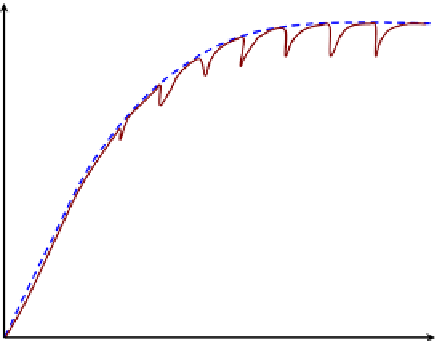Biomedical Engineering Reference
In-Depth Information
Saturation standing biomass, or biomass carrying capacity
Saturation standing biomass, or
biomass carrying capacity
X
∞
X
∞
0
1 ~ 5 years
Time
(b)
Shrubs, bamboos, etc
.
Maximum standing biomass, or
biomass carrying capacity
X
∞
0
0
0
5 ~ 80 years
0
1
2
3
4
Time
Time, years
(a)
(c)
Forest, trees.
Grasses
FIGURE 15.11
A schematic of the above ground standing biomass accumulation as a function of time in a given
area. The dotted lines represent no disturbances, whereas the solid line is drawn to show the impact of periodic
minor disturbances (Liu SJ. Woody Biomass: Niche Position as a Source of Sustainable Renewable Chemicals and
Energy and Kinetics of Hot-Water Extraction/Hydrolysis. J. Biotech. Adv. 2010; 28: 563
e
582).
for realizing the potential of woody biomass is to harvest (at least before it decomposes back
to CO
2
and H
2
O) and make room for new growth.
When intensive cultivation is an option, one needs to consider the net gain or the sustain-
ability of the cultivation process and the impact of the conversion process, as well as the bene-
fits to a regional and global economy. However, there is an upper limit on howmuch biomass
the earth can “host”, which limits the conversion site arrangement. If the earth was saturated
with plant biomass, no more net additional biomass could be added or grown. Natural
disturbances promote the plant biomass renewal while changing the level of standing
biomass temporarily. Wild fires sweep the ground from time to time reducing the standing
biomass to ashes, releasing CO
2
and H
2
O back to nature. This cycle of natural growth and
replacement keeps the plant biomass fluctuating below the saturation level. Therefore, not
utilizing the plant biomass, in particular forest biomass, does not lead to an increase in the
total amount of standing biomass on earth beyond its saturation level. Constantly harvesting
the plant biomass at or below the rate at which it could be replenished has the same effect as if
the plant biomass was left alone untouched. Sustaining the same or similar level of plant
biomass on the Earth is achievable as Nature has taught us through natural disturbances.
Therefore, harvesting and utilizing plant biomass, whether it be trees, forests, or grasses,
do not automatically lead to any net change in the biomass coverage on earth. Forests and
trees have the highest potential net energy benefit and standing quantity for a sustainable
renewable chemical and energy development.
Example 15-4. A subtropical swamp area has been found to have a biomass carrying capacity
of 2.0 kg
$
m
2
and productivity of 0.8 kg
$
m
2
$
year
1
. Because of rising demands on



























Search WWH ::

Custom Search